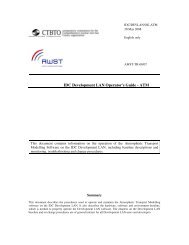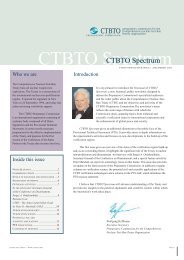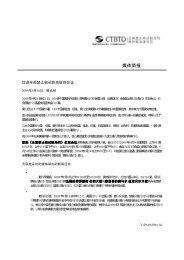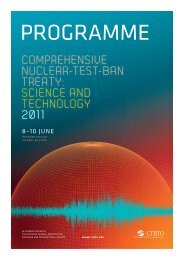ctbto Spectrum
ctbto Spectrum
ctbto Spectrum
Create successful ePaper yourself
Turn your PDF publications into a flip-book with our unique Google optimized e-Paper software.
Feature articleNuclear Weapons: An Existential Threat to Humanityby Max M. Kampelman and Thomas Graham, Jr.Sixty-three years ago last month, the beautifulcity of Hiroshima was devastated by theexplosion of an atomic bomb. The bombreleased the explosive equivalent of 12,500tons of TNT and killed – outright, or over timeby radiation poisoning – nearly 75 percent ofthe population of that city. Three days latersimilar devastation was brought to the cityof Nagasaki, and a few days after that, theSecond World War, the bloodiest and mostdestructive in the history of humanity, cameto an end.Capability to destroy theEarth several times overMany thought then, and in subsequent years,that the attacks on Hiroshima and Nagasakiwere the harbingers of the future and thatnuclear weapons were destined to spreadaround the world and be part of future wars,threatening the survival of humanity. Theseviews were reinforced by the commencementin a few years of a vast nuclear arms racewith both the United States and the SovietUnion rapidly developing the capability todestroy the Earth many times over.Over 40 States have capacityto build nuclear weaponsPresident John F. Kennedy was one of thosewho feared that nuclear weapons wouldinherit the Earth. There were predictionsduring his administration that, by the end ofthe 1970s, there could be as many as 15 to20 nuclear weapon States in the world, withnuclear weapons fully integrated into nationalarsenals. If this had happened, there wouldlikely be twice or more that many today. In2004, for example, the Director General ofthe International Atomic Energy Agency,Mohamed ElBaradei, asserted that there weremore than 40 States in the world that currentlycould build nuclear weapons, if they so chose.Such a development would have placed theworld community in a situation where everyconflict would run the risk of going nuclear andthere would be no way to keep nuclear weaponsout of the hands of terrorist organizations.Such an international security situation wouldhave made today’s time of troubles seem likeparadise by comparison.Nuclear Non-ProliferationTreaty prevents catastropheFortunately, such nuclear weapon proliferationdid not happen. President Kennedy’s darkestfears of catastrophe were not realized. Thechief reason that this did not happen wasthe entry into force of the Nuclear Non-Proliferation Treaty (NPT) in 1970, alongwith the extended deterrence policies of theUnited States and the Soviet Union. The NPTconverted what had been an act of nationalpride into an act of international outlawry.In 1960, after the first French nucleartest in the Sahara, the French newspapers wereoverflowing with nationalistic sentiment: “ViveLa France” and “Vive De Gaulle.” Switzerlandheld two national referenda and the Swisspublic twice voted to build nuclear weapons.Sweden had an active nuclear weapons researchprogram. After the NPT was in force, however,when India conducted its first nuclear weapontest in 1974, they were condemned by the entireworld and they had to hasten to declare thattheir nuclear explosion was “peaceful.”184 non-nuclear weaponStates agree not to acquirenuclear weaponsThe NPT essentially drew the line where theworld was in 1970; it recognized five existingnuclear weapon States: the United States, theSoviet Union (Russia), Britain, France, andChina. It provided that the rest of the worldwould agree not to acquire nuclear weapons.And most of the world did agree to thatproposition. Today, 184 NPT non-nuclearweapon States are committed to this obligation.Non-proliferation in exchangefor nuclear disarmamentBut the NPT did not come as a free gift fromthe rest of the world to the five nuclear weaponStates; rather it is a strategic arrangementfounded on a central bargain. That bargainwas, and is, non-proliferation in exchange forthe sharing of peaceful technology and nucleardisarmament. Nuclear disarmament wasperceived by the non-nuclear weapon States asthe five nuclear weapon States agreeing overthe long term to negotiate away their nucleararsenals so that ultimately all States wouldreceive equal treatment under the NPT.A comprehensive nuclear test banSince it was recognized that this would takesignificant time, the non-nuclear weapon Statespressed the nuclear weapon States to agree tointerim measures to include a comprehensivenuclear weapon test ban, a prohibition onthe further production of nuclear explosivematerial, a significant world-wide reduction inthe number of nuclear weapons, and bindingobligations not to use nuclear weapons againstnon-nuclear NPT parties.None of these measures 40 years laterhas been realized. One of these measures,which was seen in 1970 as a sort of litmustest which would indicate whether or not thefive nuclear weapon States would, over time,live up to their side of the central bargainwas a comprehensive nuclear test ban, whichwas included in the preamble to the NPT.Review conferences failed several times overthe years because of disagreement over thisissue. When the NPT was made a permanenttreaty in 1995, there was a recommitment toconclude a test ban in one year - that is, by1996. The non-nuclear weapons States’ viewwas, and is, that, if they are going to give upnuclear weapons, the five nuclear weaponStates could at least agree to stop testingtheir weapons.pa g e 1 0 C T B T O S p e c t r u m 1 1 | S e p t e m b e r 2 0 0 8
















